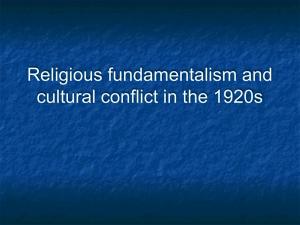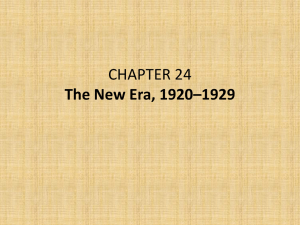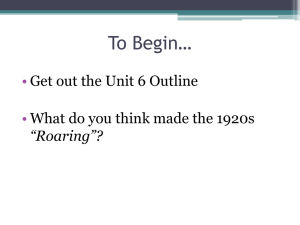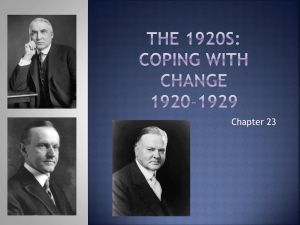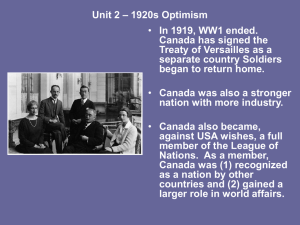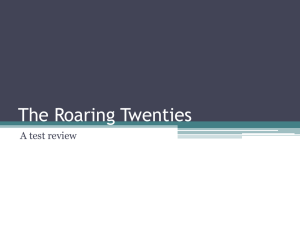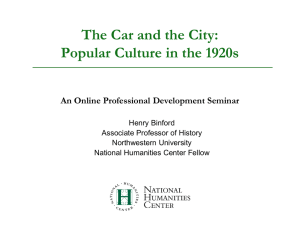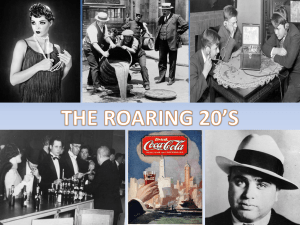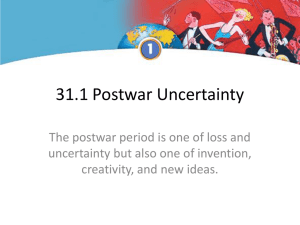US History Unit 4 Week 2 2013
advertisement
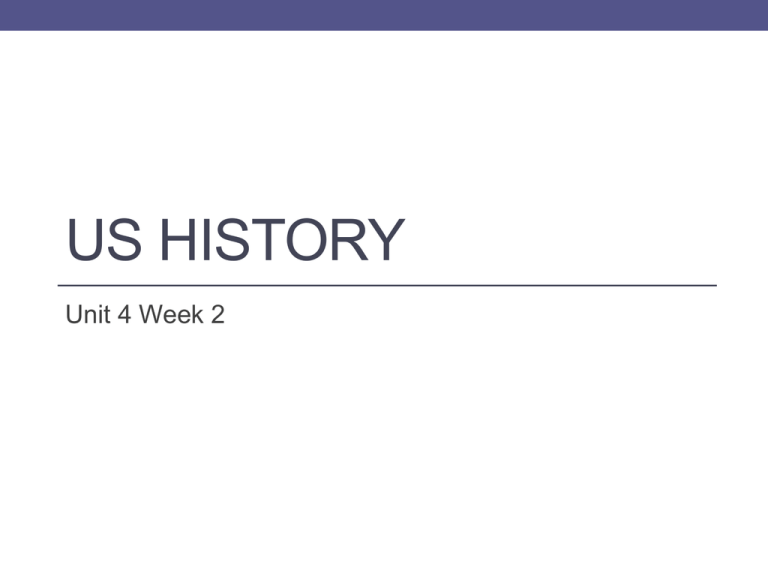
US HISTORY Unit 4 Week 2 Homework for the Week • Tuesday • Find a 2nd source for your research outline and take notes on it. • Study vocab for card quiz • Block Day • Design your perfect Ponzi scheme. 1-2 paragraphs (images optional) • Friday • Finish mini-project menu for HW Agenda, Tuesday, 11/12/2013 • Housekeeping • Hand back papers • Revision reminder • 1920s essay outline • Peer editing • Share out strong thesis statements • Researching • HW: Find a 2nd source for your research outline and take notes on it. • Study vocab for card quiz Peer review • Each partner gets 5 minutes of assistance from their partner. • Take out your work so far: 1. Together read through what you’ve written 2. Discuss what you need to edit 3. Look at the rubric and see what still needs to be done / Discuss what your next steps are • Swap and repeat the same process for the 2nd person. Peer Review: guiding questions • Step 1 • Read the thesis statement • Is it clear? • Is it specific? • Does it present an argument? • Does it outline a clear direction for the rest of your outline? • Step 2 • Read the sub-thesis (body paragraph) • Step 3 • Mark an “E” for evidence to support the thesis and sub-thesis • Is the evidence specific and supportive? • Step 4 • Mark a “C” for citations and check for complete MLA format • (Last name, Pg #) • Step 5 • Read Conclusion • Does it wrap up your argument? • Step 6 • Leave comments (be thorough!) Model thesis statements • In groups of 4, choose the strongest thesis statement of the group. • Write this thesis on the white board. • Share • What do we like about these thesis statements? Which of the grading criteria do they meet? Research time • Use the laptop computers to continue researching your topic. Cornell Notes on from a second source is HW for block day. Agenda: Wed-Thurs, 11/13-11/14 • Vocab Card quiz • HOT ROC • Review Unit 3 test • Ch. 27 – 1920s key events chart • Discuss • Complete thesis statement sentence frame • Vocab: Add speculator to your glossary • Homework: • Design your perfect Ponzi scheme. 1-2 paragraphs (images optional) HOT ROC • What examples of neutrality and diplomacy do you see in the US foreign policy of the 1920s? • Take out HW from last night for me to come around and check. The Republican Presidents & The Politics of Normalcy Did the Republican Era of the 1920s bring peace and prosperity to all Americans? Analyzing the Republican Era (27.2, 27.3, & 27.4) Event Description Define/Explain Terms Harding’s fiscal policy of free enterprise Teapot Dome Scandal Hoover allows business consolidation Florida Land Boom and Ponzi scheme Dow Jones Industrial Average and speculation American isolationism Kellogg-Briand Pact Dawes Plan Who was helped by this & why? Who was harmed by this & why (inferences are okay) Prompt: Evaluate whether the Republican Era of the 1920s brought peace and prosperity to all Americans? • Use one of the below sentence frames to help you respond to the prompt or write your own thesis statement: • The Republican Era of the 1920s brought peace and prosperity to the majority of the American people through __________________, _________________, and ______________________. • The Republican Era of the 1920s did not bring peace and prosperity to the majority of the American people because of _________________, __________________________, and ______________________. • While the Republican Era of the 1920s brought peace to the majority of Americans through _____________________, it did not bring prosperity to all Americans because ________________________ largely only benefitted _________________________________. New Vocab • Speculator/Speculation • Pg. 349 • Examples: • Stock Market • Housing • Beanie Babies Homework • Design your perfect Ponzi scheme for Monday • Use page 350 • Also, you can think about Bernard Madoff’s scheme, which came to light in 2008, http://money.howstuffworks.com/ponzischeme5.htm Agenda: Friday, 11/15 • HOT ROC: Ponzi Schemes • New Vocab: Add Consumer Culture, Popular Culture, Prohibition, and Mass Media to your glossaries • Popular Culture in the Roaring Twenties • Label notes as Political, Social or Economic • Mini-project menu • Homework: • Finish mini-project menu for HW Popular Culture in the Roaring Twenties • HOT ROC: Sell your Ponzi scheme to the class 1920s Popular Culture (vocab term) • There are several key elements in the 1920s culture. • Questioning authority • Fascination with new things • Consumerism • Leisure time • Mass communication • Contradictions Questioning authority • The horrors of World War I scarred people • People felt disillusioned with government and no longer felt a need to be obedient. • Young people felt that the older generation had mislead them. Writers like Fitzgerald and Hemingway captured these feelings. • Young women get more bold and sexy in their fashion and habits. Fascination with new things • New inventions like radio and movies were instantly popular. • Newer inventions like planes and cars became more common. • People liked breaking with tradition and being modern. • Jazz music captured this sense of freedom and breaking the rules. Consumerism • Mass production of goods and the improving economy helped Americans to afford lots of new goods. • Advertisements became more slick and were used in magazines, on the radio or made into billboards to encourage people to buy stuff. • Investing in stocks seemed like a surefire way to make money and became common among middle class people instead of just the wealthy. 1920s Advertising 1920s Advertising 1920s Advertising Leisure Time • The improved economy gave more free time to people living in cities than they had had before. • Sports, movies, beach trips, amusement parks and nightclubs became popular outings for the increasing middle class. • People also enjoyed “taboo” activities like hearing jazz in Harlem nightclubs or going to illegal bars known as speakeasies. Mass Communication • Movies and radio shows were enjoyed by people throughout the country. • For the first time, people were all experiencing the same entertainment. • Created a common mass culture . Prohibition • The 18th Amendment outlawed alcohol in 1919. • At first it was believed that alcohol would just be illegal in saloons but still legal for people to consume at home. • When all alcohol was banned, many people felt they were justified in bending or breaking this laws. • Organized crime grew in cities to supply the people with alcohol. Mini Project Menu • Use the themes of the 1920s in completing one of the following creative writing assignments: 1. 2. 3. 4. • Write a short story in which a young man or woman questions authority Write the radio broadcast of a sports announcer commenting on Babe Ruth winning a game for the Yankees. Write an advice column to a couple who have gotten caught up in consumerism and are now in debt. Write a news report on a speakeasy raid or a street fight between the cops and bootleggers. Use chapter 28, sections 1-4 for assistance, if necessary
